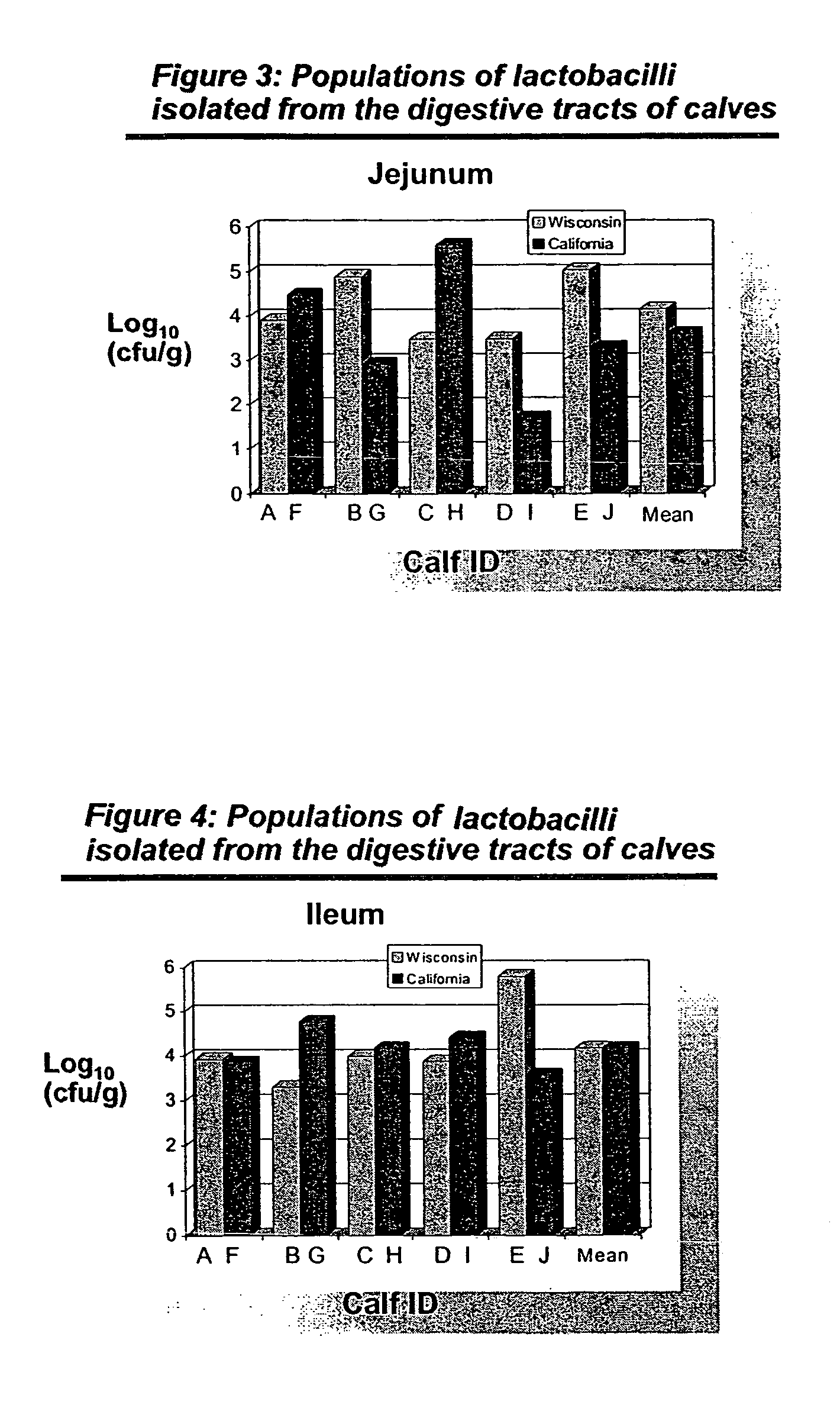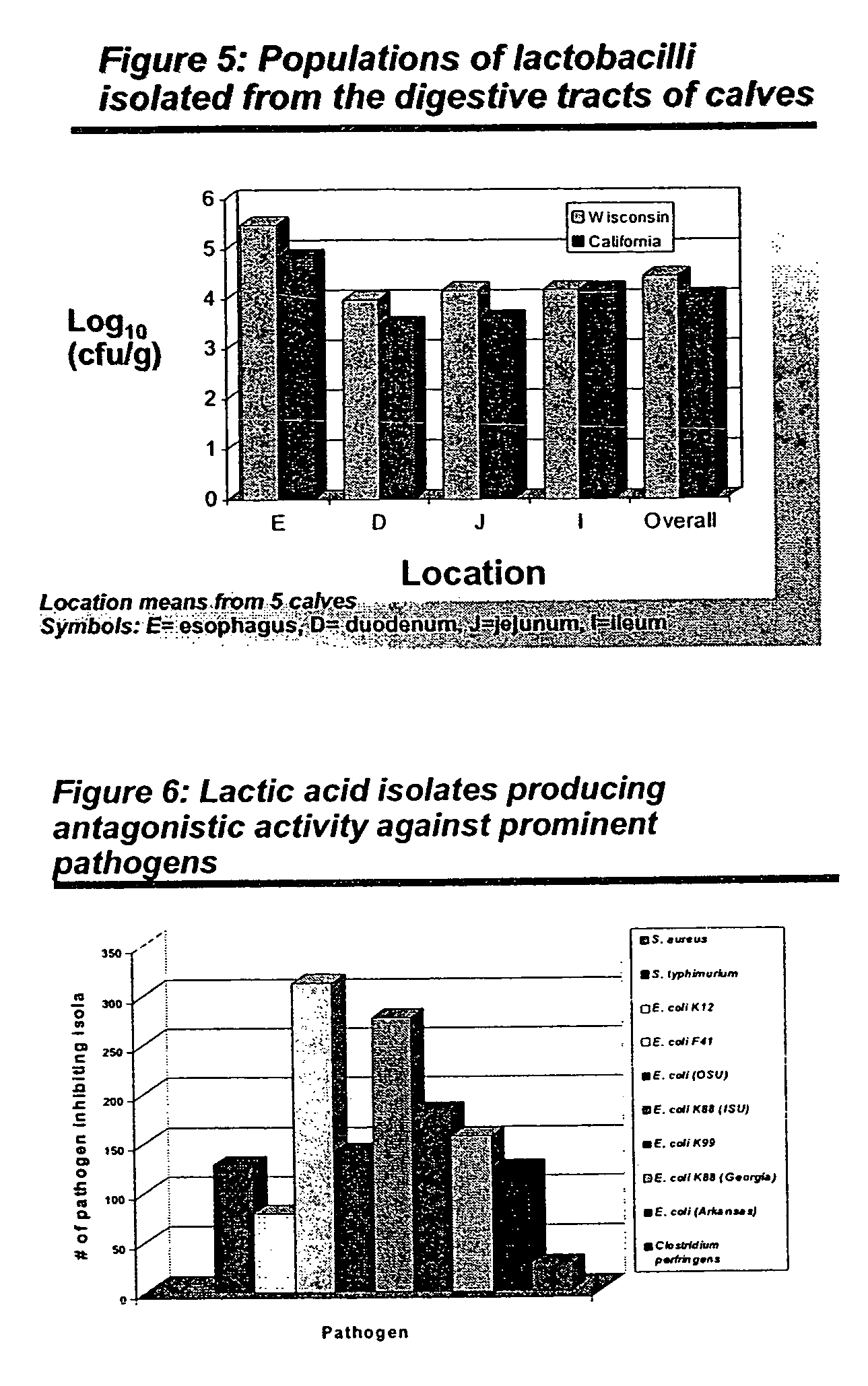Lactic acid bacteria and its use in direct-fed microbials
a technology direct-fed microbials, which is applied in the field can solve the problems of poor knowledge of the distribution and diversity of lactic acid bacteria in the intestinal tract of pre-weaned calves, no proven efficacy of direct-fed microbials for animal feeding, and limited use of ionophores, so as to improve the intestinal health of dairy replacement calves, improve performance in the animal, and reduce scours in the animal
- Summary
- Abstract
- Description
- Claims
- Application Information
AI Technical Summary
Benefits of technology
Problems solved by technology
Method used
Image
Examples
example 1
Isolation of Lactic Acid Bacteria
A. Materials and Methods
[0047]1. Calf Selection and Intestinal Extraction Procedures:
[0048]A total of ten healthy, pre-weaned calves (approximately 80 lbs each) were purchased from separate sale barns in Wisconsin (five calves) and California (five calves). Calves were killed by exsanguation and samples of the esophagus, duodenum, jejunum, and ileum were aseptically removed along with 25 g samples of fecal and stomach contents from each calf. The intestinal, fecal, and stomach samples were transported to Agtech Products Inc., for dissection and culture isolation.
[0049]2. Isolation and Culture Maintenance Procedures:
[0050]Esophageal, duodenal, jejunal, and ileal sections were washed with 100 ml of sterile buffer (0.3 mM KH2PO4, 1 mM MgSO4, 0.05% cysteine hydrochloride, pH 7.0), and cut open with surgical scissors to expose the epithelial lining. To remove lactic acid bacterial cells from intestinal tissue, 22 g samples of the intestinal tissue were pl...
example 2
Antimicrobial Spot Assay Procedures
A. Materials and Methods
[0065]Spent broth from a 24-hour culture of each isolate was spotted onto Tryptic Soy Agar (TSA) plates inoculated at 1% with a selected pathogen. Pathogens were prepared by growth at 37° C. in Tryptic Soy Broth to an optical density of 0.60 at 600 nm prior to inoculation into TSA. Preparation of the spent broth from lactic acid isolates involved adjusting the pH of each broth sample to neutral levels (6.5-7.5). This process eliminated the possible antimicrobial effects of acid on the pathogens. All lactic acid bacterial isolates were challenged with a broad range of pathogens including Staphylococcus aureus, Salmonella typhimurium, E. coli K12, E. coli F41 (Purdue Univ., Ind.), E. coli (Oklahoma State Univ.), E. coli K88 (Iowa State Univ.), E. coli K99 (Texas A&M University), E. coli K88 (Georgia), E. coli (Arkansas), and Clostridium perfringens.
[0066]Forty-one lactic acid isolates were chosen for further screening based o...
example 3
Animal Trials
A. Materials and Methods
[0071]1. General Trial Protocols:
[0072]Two experiments (Experiments 1 and 2) were conducted using a randomized complete block design. Holstein bull calves (n=60 per trial) were purchased from an area sale barn and transported to Merrick Animal Nutrition, Inc. Calf Research Farm. On arrival, calves were weighed and assigned to a treatment and hutch depending on the initial weight of the animal. Jugular blood samples were collected and centrifuged for testing serum IgG levels with a Palm Lab (PalmLab, Inc. Newburg, Wis.).
[0073]All calves were fed a standard all milk replacer diet. (Gold Star, Merrick's Animal Nutrition, Union Center, Wis.) medicated with Neo-Oxy 100 / 50 MR (Penn Field Animal Health, Omaha, Nebr.) at 454 g / d reconstituted to 12% DM. Nutrient compositions of final diets are found in Table 2 below. Analyses of final milk replacer diets were completed using approved Association of Analytical Chemists (AOAC) methods.
[0074]
TABLE 2Nutrient...
PUM
| Property | Measurement | Unit |
|---|---|---|
| pH | aaaaa | aaaaa |
| volumes | aaaaa | aaaaa |
| optical density | aaaaa | aaaaa |
Abstract
Description
Claims
Application Information
 Login to View More
Login to View More - R&D
- Intellectual Property
- Life Sciences
- Materials
- Tech Scout
- Unparalleled Data Quality
- Higher Quality Content
- 60% Fewer Hallucinations
Browse by: Latest US Patents, China's latest patents, Technical Efficacy Thesaurus, Application Domain, Technology Topic, Popular Technical Reports.
© 2025 PatSnap. All rights reserved.Legal|Privacy policy|Modern Slavery Act Transparency Statement|Sitemap|About US| Contact US: help@patsnap.com



